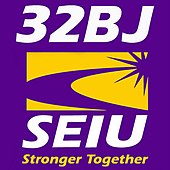SEIU 32BJ
 |
|
| Full name | Service Employees International Union, Local 32BJ |
|---|---|
| Founded | April 19, 1934 as BSEIU Local 32B |
| Members | 133,019 (2013) |
| Affiliation | Service Employees International Union |
| Key people | Héctor Figueroa, President |
| Office location | New York, NY |
| Country | United States |
| Website | seiu32bj |
Service Employees International Union, Local 32B, often shortened to 32BJ SEIU or 32BJ, is a branch of Service Employees International Union headquartered in New York City representing over 120,000 members in eight northeastern states and Washington, D.C. The largest property service workers labor union in the United States, 32BJ members include office cleaners, security officers, doormen, porters, maintenance workers, bus drivers and aides, window cleaners, school cleaners, and food service workers.
According to SEIU 32BJ's Department of Labor records since 2005, when membership classifications were first reported, around a quarter of the union's membership are considered part time.
Between 1902 and 1920, attempts were made to form janitor’s unions, but disadvantages were overwhelming. The American Federation of Labor (AFL) chartered a few early janitor locals but remained chiefly concerned with more skilled trades.
In 1921, seven small local unions led by William F. Quesse of the Chicago Flat Janitors received an AFL charter as the Building Service Employees International Union. By 1928 BSEIU membership had grown to 7,000 members across 50 small locals, with most of the strength still centered in Chicago.
The Great Depression caused many BSEIU locals to fall by the wayside, and the situation in New York City was especially hard. Local 32, Superintendents and Janitors, suffered a wage cut. Locals 58 and 51 were dwindling in members, and Local 14, Harlem Superintendents, had folded. New York janitors and others were working under conditions the Chicago Flat Janitors had won 20 years earlier.
BSEIU Local 58 disintegrated in the face of a 1933 membership revolt led by elevator operators David Sullivan, Thomas Shortman, Arthur Harckham, and Thomas Young. The 500 dissenting members applied to BSEIU, now led by Jerry Horan, but were turned down. Joined by Local 32, they formed an independent union in February 1934.
In March 1934, Thomas Young and James Bambrick led the union’s first successful strike against a Seventh Avenue building, and by mid-April Bambrick succeeded in obtaining a BSEIU charter for the new local, and Local 32B was born.
...
Wikipedia
